Ethical and Safety Analysis of Self-Driving Car Software Development
VerifiedAdded on 2022/09/28
|10
|2422
|24
Report
AI Summary
This report delves into the ethical decisions inherent in the software development of self-driving cars, emphasizing the multifaceted considerations required for safe and responsible autonomous vehicle deployment. It examines the societal, economic, engineering design, and ethical factors that must be addressed. The report highlights the role of software engineering solutions in managing ethical and social challenges, analyzing case studies to illustrate real-world implications, such as accidents caused by software errors and the complexities of assigning liability. It discusses the importance of comprehensive testing, the standardization of AI algorithms, and the increasing responsibility of car manufacturers and software developers as automation levels rise. Recommendations include the use of regulating instruments and standards, and the development of more efficient and detailed algorithms to enhance safety and mitigate risks associated with autonomous vehicle technology. The report stresses the need for continuous improvement and ethical oversight to ensure the safe integration of self-driving cars into society.
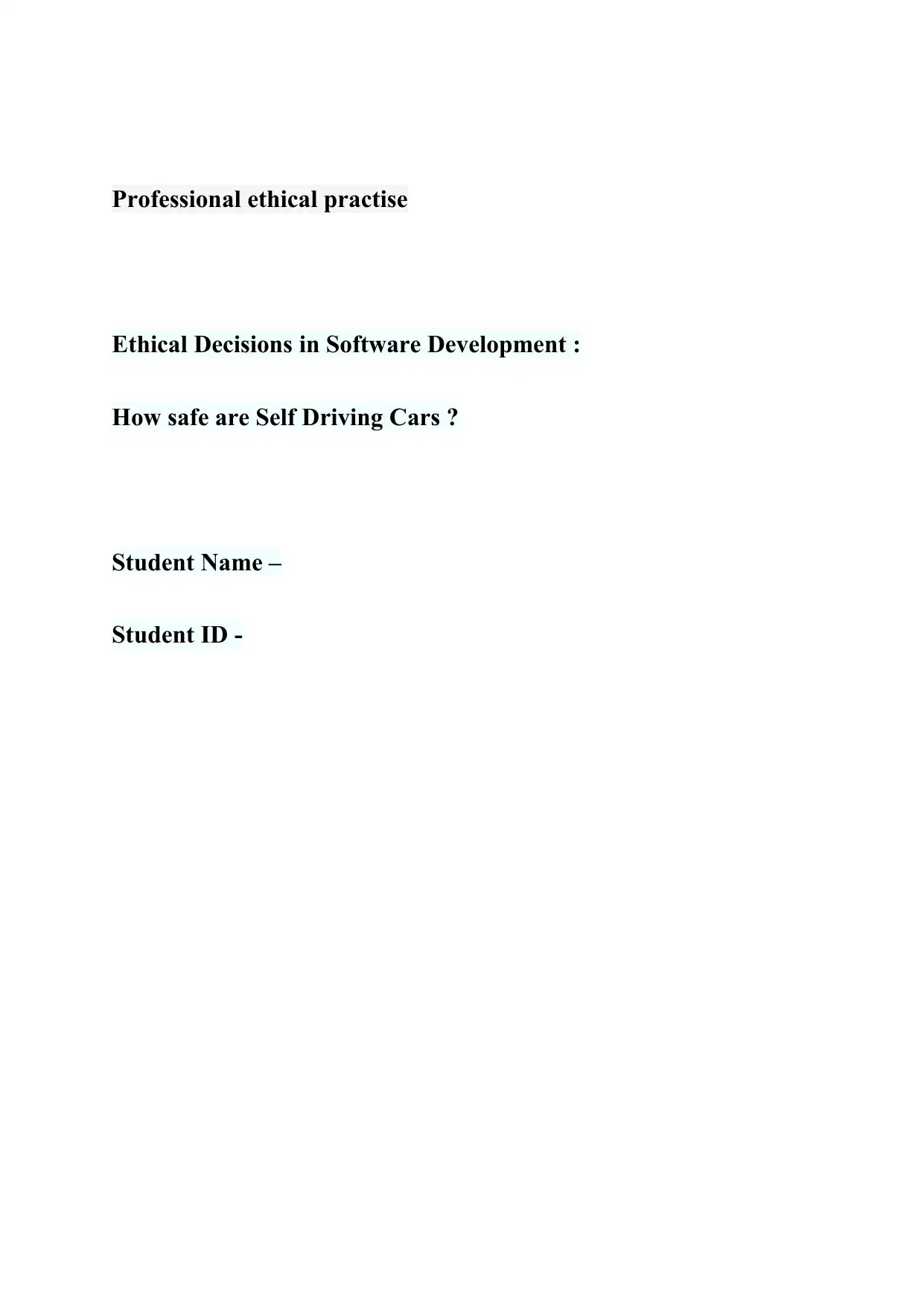
Professional ethical practise
Ethical Decisions in Software Development :
How safe are Self Driving Cars ?
Student Name –
Student ID -
Ethical Decisions in Software Development :
How safe are Self Driving Cars ?
Student Name –
Student ID -
Paraphrase This Document
Need a fresh take? Get an instant paraphrase of this document with our AI Paraphraser
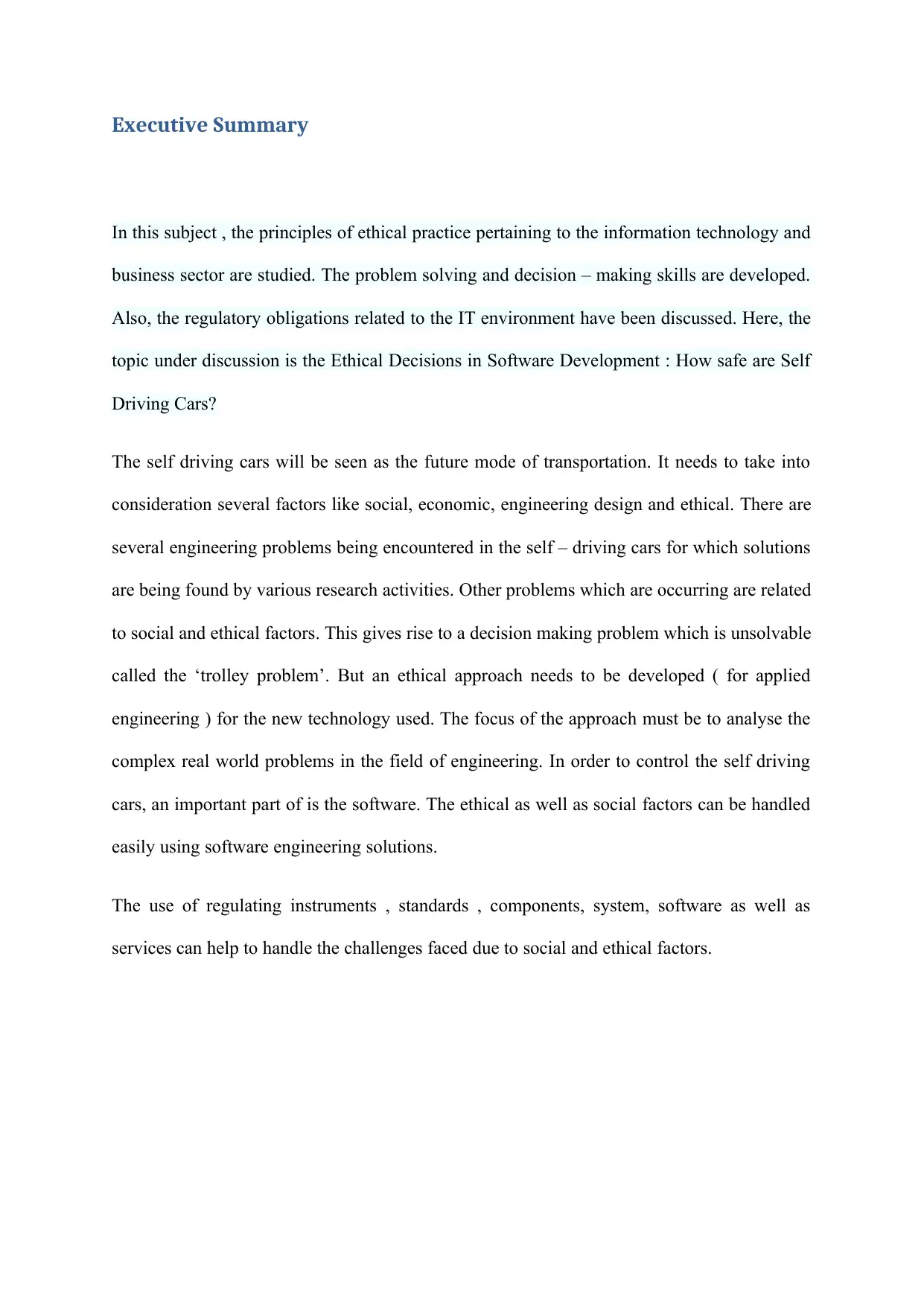
Executive Summary
In this subject , the principles of ethical practice pertaining to the information technology and
business sector are studied. The problem solving and decision – making skills are developed.
Also, the regulatory obligations related to the IT environment have been discussed. Here, the
topic under discussion is the Ethical Decisions in Software Development : How safe are Self
Driving Cars?
The self driving cars will be seen as the future mode of transportation. It needs to take into
consideration several factors like social, economic, engineering design and ethical. There are
several engineering problems being encountered in the self – driving cars for which solutions
are being found by various research activities. Other problems which are occurring are related
to social and ethical factors. This gives rise to a decision making problem which is unsolvable
called the ‘trolley problem’. But an ethical approach needs to be developed ( for applied
engineering ) for the new technology used. The focus of the approach must be to analyse the
complex real world problems in the field of engineering. In order to control the self driving
cars, an important part of is the software. The ethical as well as social factors can be handled
easily using software engineering solutions.
The use of regulating instruments , standards , components, system, software as well as
services can help to handle the challenges faced due to social and ethical factors.
In this subject , the principles of ethical practice pertaining to the information technology and
business sector are studied. The problem solving and decision – making skills are developed.
Also, the regulatory obligations related to the IT environment have been discussed. Here, the
topic under discussion is the Ethical Decisions in Software Development : How safe are Self
Driving Cars?
The self driving cars will be seen as the future mode of transportation. It needs to take into
consideration several factors like social, economic, engineering design and ethical. There are
several engineering problems being encountered in the self – driving cars for which solutions
are being found by various research activities. Other problems which are occurring are related
to social and ethical factors. This gives rise to a decision making problem which is unsolvable
called the ‘trolley problem’. But an ethical approach needs to be developed ( for applied
engineering ) for the new technology used. The focus of the approach must be to analyse the
complex real world problems in the field of engineering. In order to control the self driving
cars, an important part of is the software. The ethical as well as social factors can be handled
easily using software engineering solutions.
The use of regulating instruments , standards , components, system, software as well as
services can help to handle the challenges faced due to social and ethical factors.

Contents
Executive Summary...............................................................................................................................2
Introduction...........................................................................................................................................4
Ethical Decisions in Software Development :........................................................................................4
Case Study :.......................................................................................................................................4
Discussion..........................................................................................................................................6
Conclusion.............................................................................................................................................7
Recommendations.................................................................................................................................8
References.............................................................................................................................................8
Executive Summary...............................................................................................................................2
Introduction...........................................................................................................................................4
Ethical Decisions in Software Development :........................................................................................4
Case Study :.......................................................................................................................................4
Discussion..........................................................................................................................................6
Conclusion.............................................................................................................................................7
Recommendations.................................................................................................................................8
References.............................................................................................................................................8
⊘ This is a preview!⊘
Do you want full access?
Subscribe today to unlock all pages.

Trusted by 1+ million students worldwide
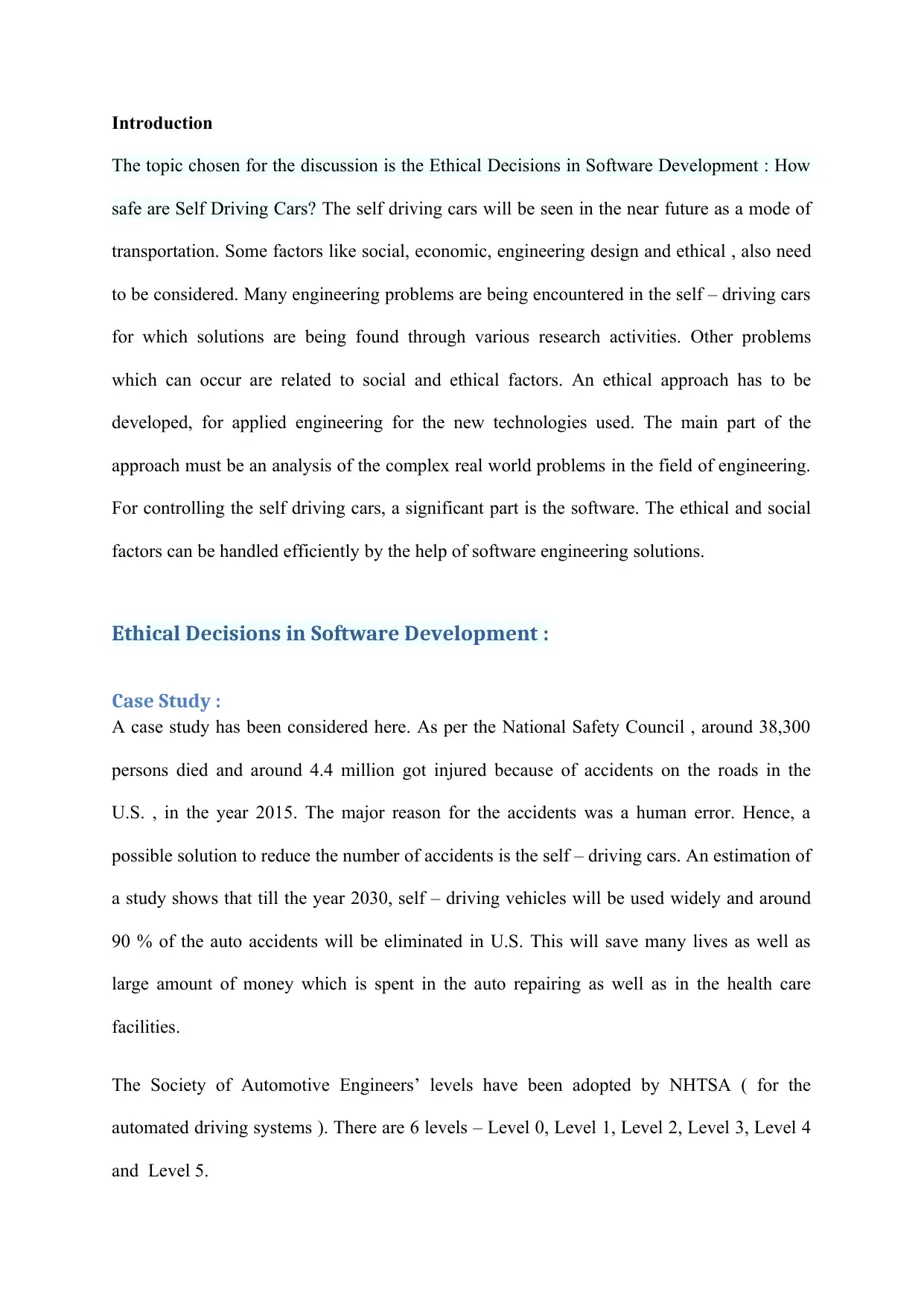
Introduction
The topic chosen for the discussion is the Ethical Decisions in Software Development : How
safe are Self Driving Cars? The self driving cars will be seen in the near future as a mode of
transportation. Some factors like social, economic, engineering design and ethical , also need
to be considered. Many engineering problems are being encountered in the self – driving cars
for which solutions are being found through various research activities. Other problems
which can occur are related to social and ethical factors. An ethical approach has to be
developed, for applied engineering for the new technologies used. The main part of the
approach must be an analysis of the complex real world problems in the field of engineering.
For controlling the self driving cars, a significant part is the software. The ethical and social
factors can be handled efficiently by the help of software engineering solutions.
Ethical Decisions in Software Development :
Case Study :
A case study has been considered here. As per the National Safety Council , around 38,300
persons died and around 4.4 million got injured because of accidents on the roads in the
U.S. , in the year 2015. The major reason for the accidents was a human error. Hence, a
possible solution to reduce the number of accidents is the self – driving cars. An estimation of
a study shows that till the year 2030, self – driving vehicles will be used widely and around
90 % of the auto accidents will be eliminated in U.S. This will save many lives as well as
large amount of money which is spent in the auto repairing as well as in the health care
facilities.
The Society of Automotive Engineers’ levels have been adopted by NHTSA ( for the
automated driving systems ). There are 6 levels – Level 0, Level 1, Level 2, Level 3, Level 4
and Level 5.
The topic chosen for the discussion is the Ethical Decisions in Software Development : How
safe are Self Driving Cars? The self driving cars will be seen in the near future as a mode of
transportation. Some factors like social, economic, engineering design and ethical , also need
to be considered. Many engineering problems are being encountered in the self – driving cars
for which solutions are being found through various research activities. Other problems
which can occur are related to social and ethical factors. An ethical approach has to be
developed, for applied engineering for the new technologies used. The main part of the
approach must be an analysis of the complex real world problems in the field of engineering.
For controlling the self driving cars, a significant part is the software. The ethical and social
factors can be handled efficiently by the help of software engineering solutions.
Ethical Decisions in Software Development :
Case Study :
A case study has been considered here. As per the National Safety Council , around 38,300
persons died and around 4.4 million got injured because of accidents on the roads in the
U.S. , in the year 2015. The major reason for the accidents was a human error. Hence, a
possible solution to reduce the number of accidents is the self – driving cars. An estimation of
a study shows that till the year 2030, self – driving vehicles will be used widely and around
90 % of the auto accidents will be eliminated in U.S. This will save many lives as well as
large amount of money which is spent in the auto repairing as well as in the health care
facilities.
The Society of Automotive Engineers’ levels have been adopted by NHTSA ( for the
automated driving systems ). There are 6 levels – Level 0, Level 1, Level 2, Level 3, Level 4
and Level 5.
Paraphrase This Document
Need a fresh take? Get an instant paraphrase of this document with our AI Paraphraser
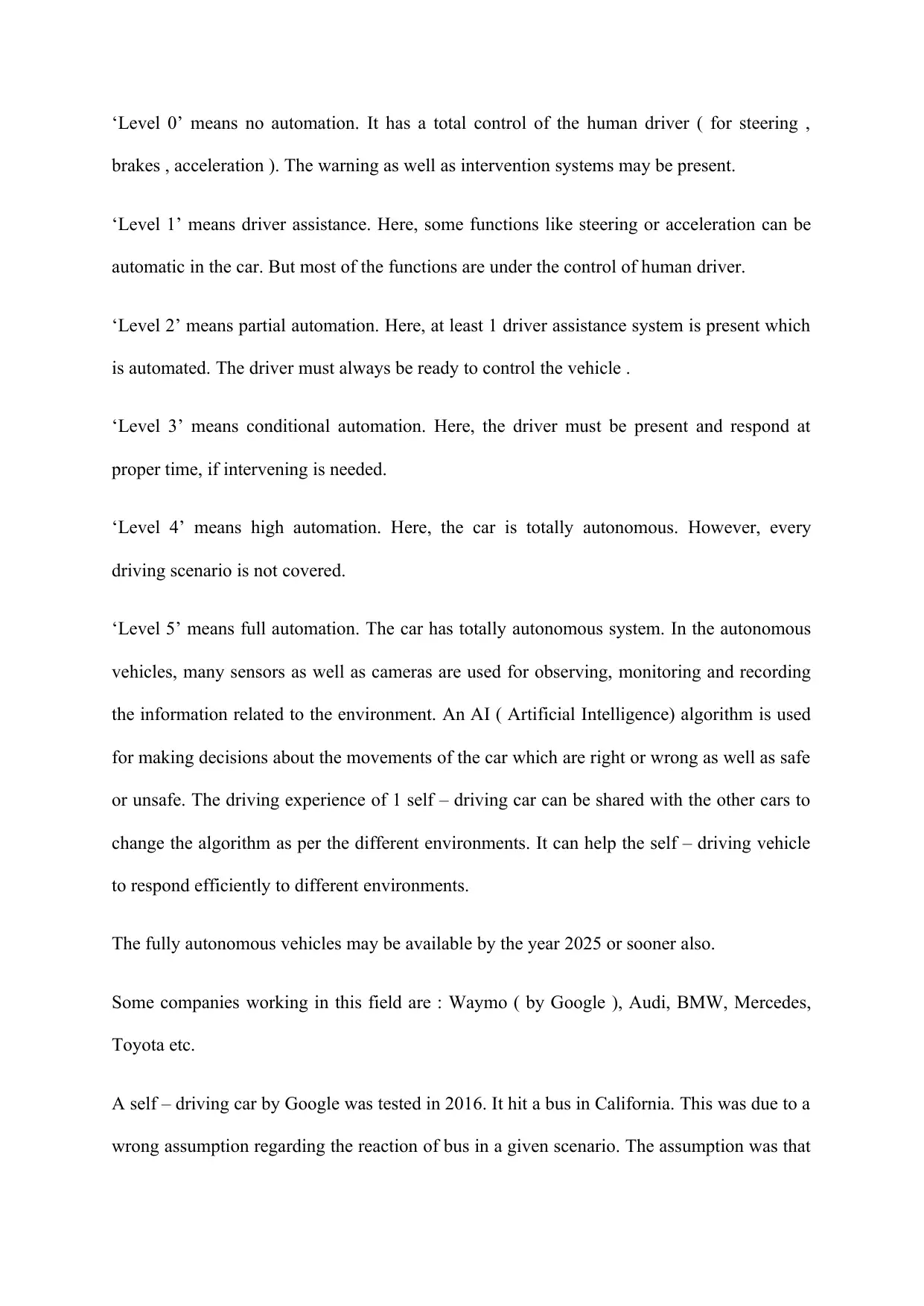
‘Level 0’ means no automation. It has a total control of the human driver ( for steering ,
brakes , acceleration ). The warning as well as intervention systems may be present.
‘Level 1’ means driver assistance. Here, some functions like steering or acceleration can be
automatic in the car. But most of the functions are under the control of human driver.
‘Level 2’ means partial automation. Here, at least 1 driver assistance system is present which
is automated. The driver must always be ready to control the vehicle .
‘Level 3’ means conditional automation. Here, the driver must be present and respond at
proper time, if intervening is needed.
‘Level 4’ means high automation. Here, the car is totally autonomous. However, every
driving scenario is not covered.
‘Level 5’ means full automation. The car has totally autonomous system. In the autonomous
vehicles, many sensors as well as cameras are used for observing, monitoring and recording
the information related to the environment. An AI ( Artificial Intelligence) algorithm is used
for making decisions about the movements of the car which are right or wrong as well as safe
or unsafe. The driving experience of 1 self – driving car can be shared with the other cars to
change the algorithm as per the different environments. It can help the self – driving vehicle
to respond efficiently to different environments.
The fully autonomous vehicles may be available by the year 2025 or sooner also.
Some companies working in this field are : Waymo ( by Google ), Audi, BMW, Mercedes,
Toyota etc.
A self – driving car by Google was tested in 2016. It hit a bus in California. This was due to a
wrong assumption regarding the reaction of bus in a given scenario. The assumption was that
brakes , acceleration ). The warning as well as intervention systems may be present.
‘Level 1’ means driver assistance. Here, some functions like steering or acceleration can be
automatic in the car. But most of the functions are under the control of human driver.
‘Level 2’ means partial automation. Here, at least 1 driver assistance system is present which
is automated. The driver must always be ready to control the vehicle .
‘Level 3’ means conditional automation. Here, the driver must be present and respond at
proper time, if intervening is needed.
‘Level 4’ means high automation. Here, the car is totally autonomous. However, every
driving scenario is not covered.
‘Level 5’ means full automation. The car has totally autonomous system. In the autonomous
vehicles, many sensors as well as cameras are used for observing, monitoring and recording
the information related to the environment. An AI ( Artificial Intelligence) algorithm is used
for making decisions about the movements of the car which are right or wrong as well as safe
or unsafe. The driving experience of 1 self – driving car can be shared with the other cars to
change the algorithm as per the different environments. It can help the self – driving vehicle
to respond efficiently to different environments.
The fully autonomous vehicles may be available by the year 2025 or sooner also.
Some companies working in this field are : Waymo ( by Google ), Audi, BMW, Mercedes,
Toyota etc.
A self – driving car by Google was tested in 2016. It hit a bus in California. This was due to a
wrong assumption regarding the reaction of bus in a given scenario. The assumption was that
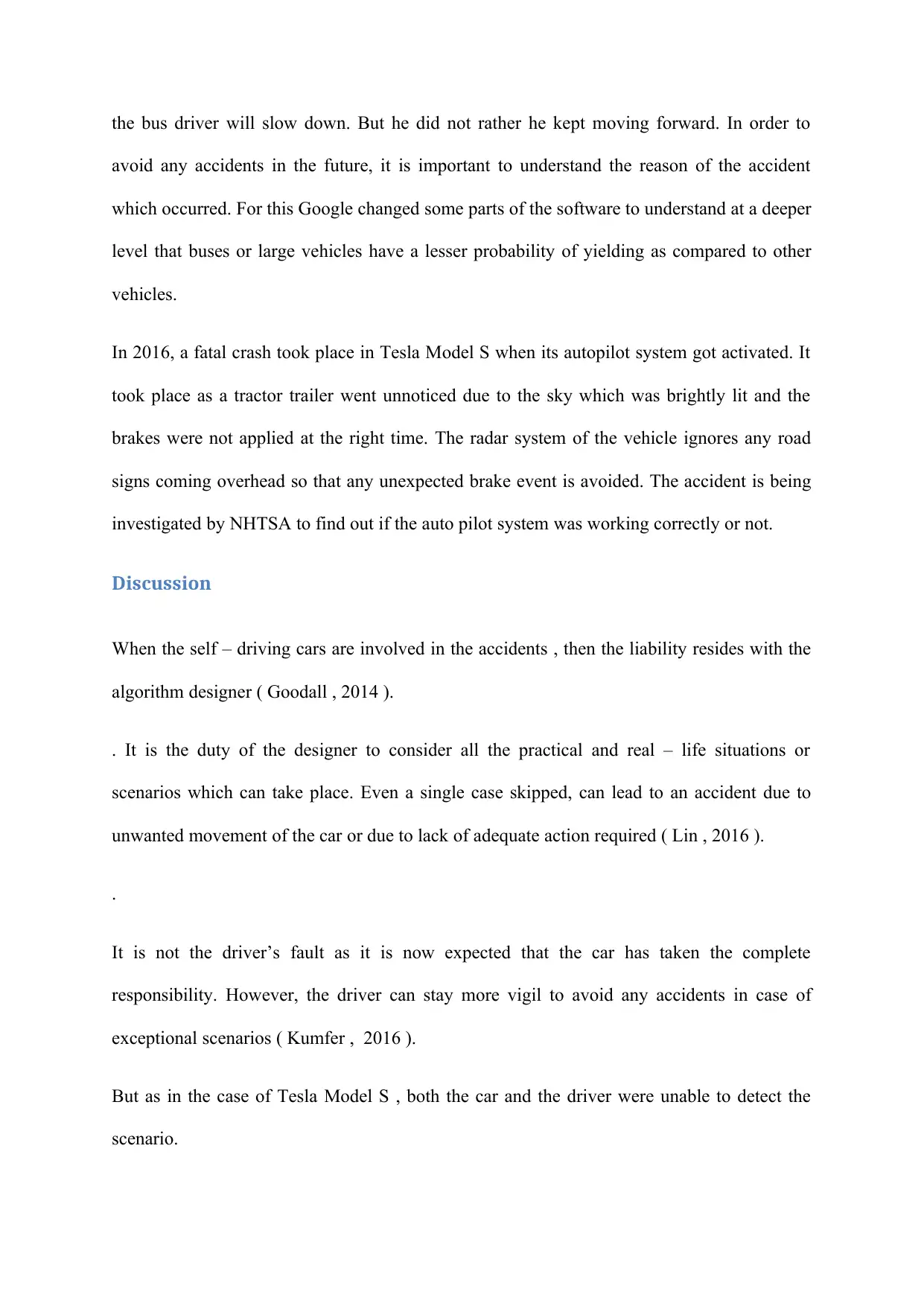
the bus driver will slow down. But he did not rather he kept moving forward. In order to
avoid any accidents in the future, it is important to understand the reason of the accident
which occurred. For this Google changed some parts of the software to understand at a deeper
level that buses or large vehicles have a lesser probability of yielding as compared to other
vehicles.
In 2016, a fatal crash took place in Tesla Model S when its autopilot system got activated. It
took place as a tractor trailer went unnoticed due to the sky which was brightly lit and the
brakes were not applied at the right time. The radar system of the vehicle ignores any road
signs coming overhead so that any unexpected brake event is avoided. The accident is being
investigated by NHTSA to find out if the auto pilot system was working correctly or not.
Discussion
When the self – driving cars are involved in the accidents , then the liability resides with the
algorithm designer ( Goodall , 2014 ).
. It is the duty of the designer to consider all the practical and real – life situations or
scenarios which can take place. Even a single case skipped, can lead to an accident due to
unwanted movement of the car or due to lack of adequate action required ( Lin , 2016 ).
.
It is not the driver’s fault as it is now expected that the car has taken the complete
responsibility. However, the driver can stay more vigil to avoid any accidents in case of
exceptional scenarios ( Kumfer , 2016 ).
But as in the case of Tesla Model S , both the car and the driver were unable to detect the
scenario.
avoid any accidents in the future, it is important to understand the reason of the accident
which occurred. For this Google changed some parts of the software to understand at a deeper
level that buses or large vehicles have a lesser probability of yielding as compared to other
vehicles.
In 2016, a fatal crash took place in Tesla Model S when its autopilot system got activated. It
took place as a tractor trailer went unnoticed due to the sky which was brightly lit and the
brakes were not applied at the right time. The radar system of the vehicle ignores any road
signs coming overhead so that any unexpected brake event is avoided. The accident is being
investigated by NHTSA to find out if the auto pilot system was working correctly or not.
Discussion
When the self – driving cars are involved in the accidents , then the liability resides with the
algorithm designer ( Goodall , 2014 ).
. It is the duty of the designer to consider all the practical and real – life situations or
scenarios which can take place. Even a single case skipped, can lead to an accident due to
unwanted movement of the car or due to lack of adequate action required ( Lin , 2016 ).
.
It is not the driver’s fault as it is now expected that the car has taken the complete
responsibility. However, the driver can stay more vigil to avoid any accidents in case of
exceptional scenarios ( Kumfer , 2016 ).
But as in the case of Tesla Model S , both the car and the driver were unable to detect the
scenario.
⊘ This is a preview!⊘
Do you want full access?
Subscribe today to unlock all pages.

Trusted by 1+ million students worldwide
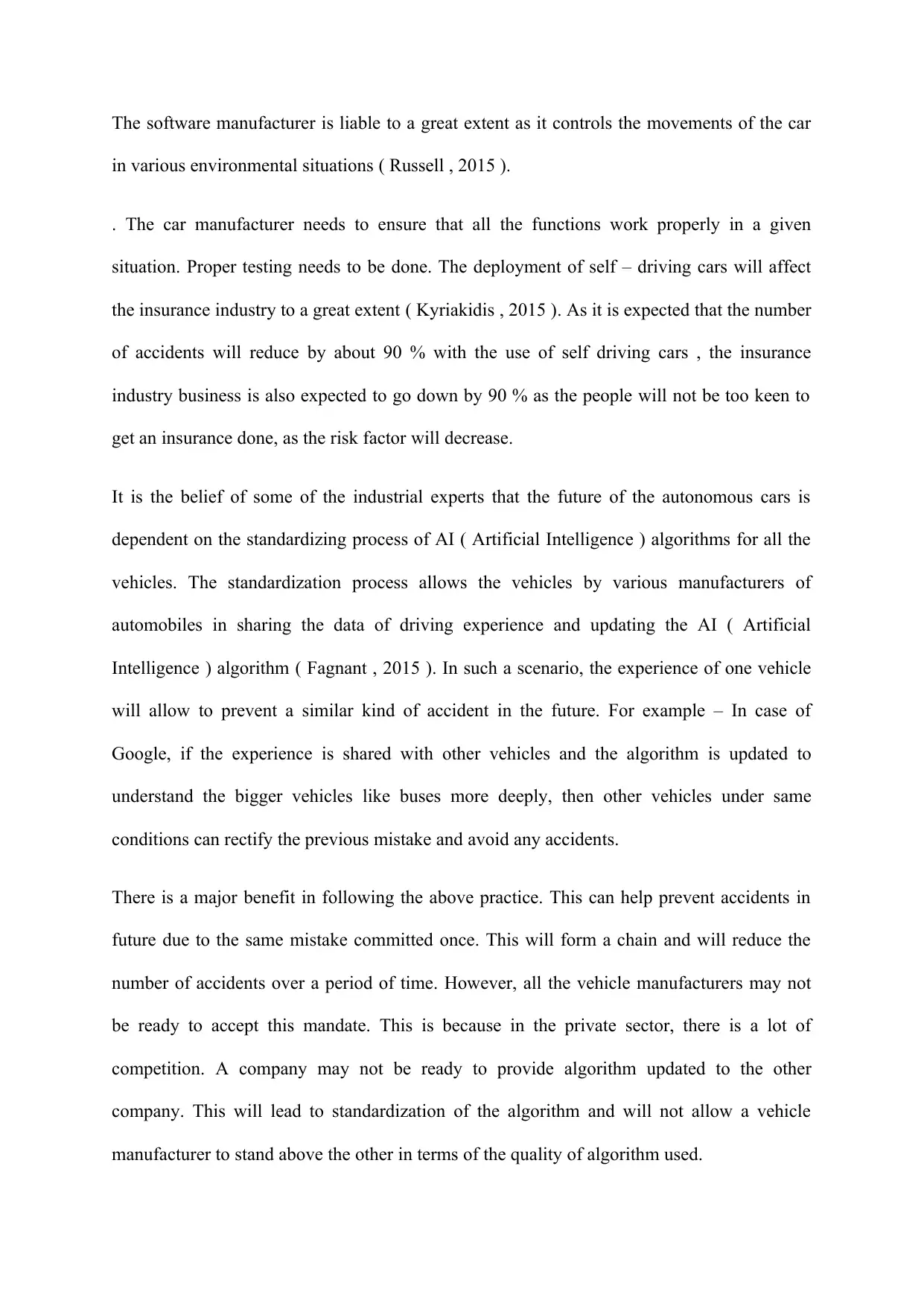
The software manufacturer is liable to a great extent as it controls the movements of the car
in various environmental situations ( Russell , 2015 ).
. The car manufacturer needs to ensure that all the functions work properly in a given
situation. Proper testing needs to be done. The deployment of self – driving cars will affect
the insurance industry to a great extent ( Kyriakidis , 2015 ). As it is expected that the number
of accidents will reduce by about 90 % with the use of self driving cars , the insurance
industry business is also expected to go down by 90 % as the people will not be too keen to
get an insurance done, as the risk factor will decrease.
It is the belief of some of the industrial experts that the future of the autonomous cars is
dependent on the standardizing process of AI ( Artificial Intelligence ) algorithms for all the
vehicles. The standardization process allows the vehicles by various manufacturers of
automobiles in sharing the data of driving experience and updating the AI ( Artificial
Intelligence ) algorithm ( Fagnant , 2015 ). In such a scenario, the experience of one vehicle
will allow to prevent a similar kind of accident in the future. For example – In case of
Google, if the experience is shared with other vehicles and the algorithm is updated to
understand the bigger vehicles like buses more deeply, then other vehicles under same
conditions can rectify the previous mistake and avoid any accidents.
There is a major benefit in following the above practice. This can help prevent accidents in
future due to the same mistake committed once. This will form a chain and will reduce the
number of accidents over a period of time. However, all the vehicle manufacturers may not
be ready to accept this mandate. This is because in the private sector, there is a lot of
competition. A company may not be ready to provide algorithm updated to the other
company. This will lead to standardization of the algorithm and will not allow a vehicle
manufacturer to stand above the other in terms of the quality of algorithm used.
in various environmental situations ( Russell , 2015 ).
. The car manufacturer needs to ensure that all the functions work properly in a given
situation. Proper testing needs to be done. The deployment of self – driving cars will affect
the insurance industry to a great extent ( Kyriakidis , 2015 ). As it is expected that the number
of accidents will reduce by about 90 % with the use of self driving cars , the insurance
industry business is also expected to go down by 90 % as the people will not be too keen to
get an insurance done, as the risk factor will decrease.
It is the belief of some of the industrial experts that the future of the autonomous cars is
dependent on the standardizing process of AI ( Artificial Intelligence ) algorithms for all the
vehicles. The standardization process allows the vehicles by various manufacturers of
automobiles in sharing the data of driving experience and updating the AI ( Artificial
Intelligence ) algorithm ( Fagnant , 2015 ). In such a scenario, the experience of one vehicle
will allow to prevent a similar kind of accident in the future. For example – In case of
Google, if the experience is shared with other vehicles and the algorithm is updated to
understand the bigger vehicles like buses more deeply, then other vehicles under same
conditions can rectify the previous mistake and avoid any accidents.
There is a major benefit in following the above practice. This can help prevent accidents in
future due to the same mistake committed once. This will form a chain and will reduce the
number of accidents over a period of time. However, all the vehicle manufacturers may not
be ready to accept this mandate. This is because in the private sector, there is a lot of
competition. A company may not be ready to provide algorithm updated to the other
company. This will lead to standardization of the algorithm and will not allow a vehicle
manufacturer to stand above the other in terms of the quality of algorithm used.
Paraphrase This Document
Need a fresh take? Get an instant paraphrase of this document with our AI Paraphraser
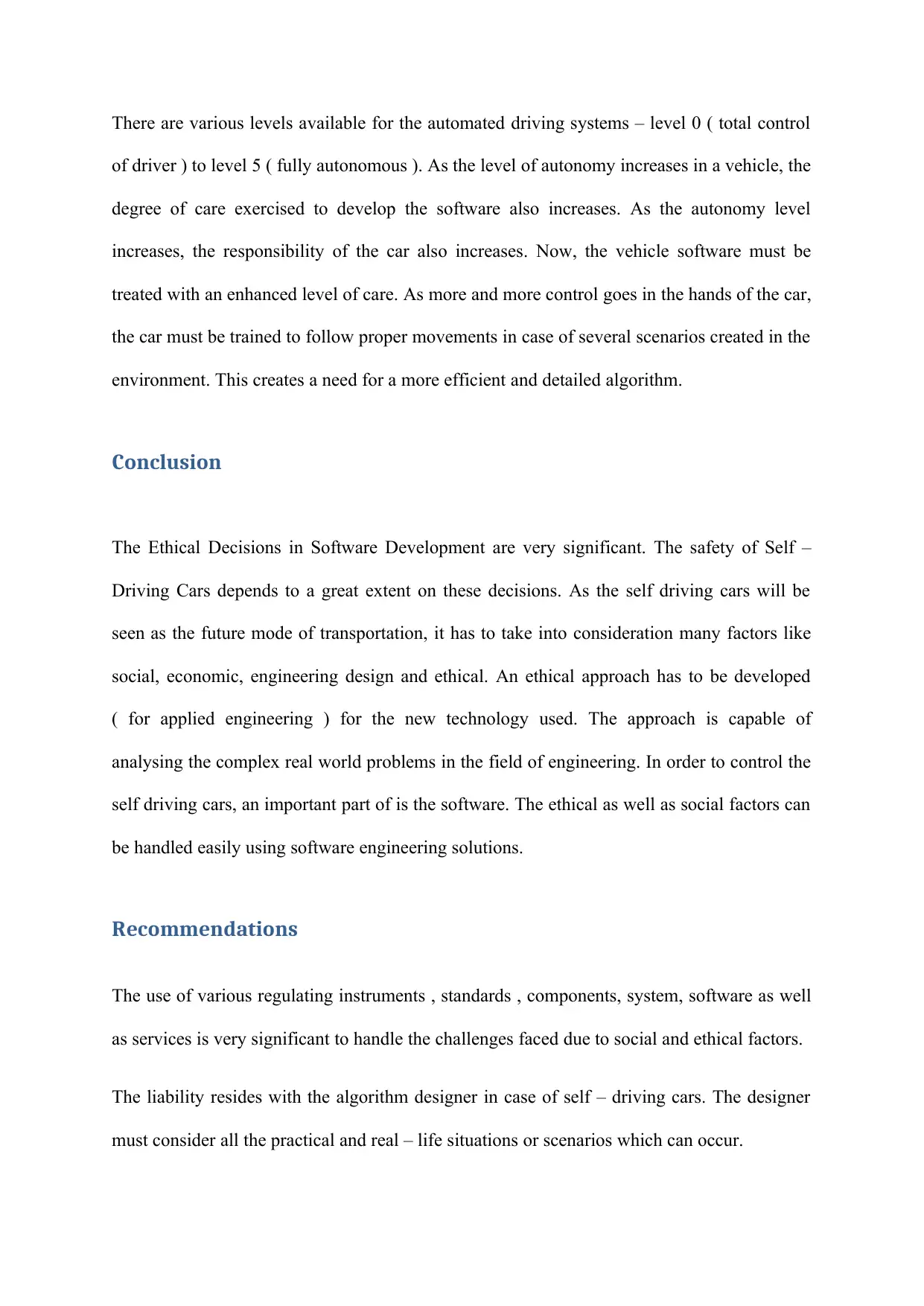
There are various levels available for the automated driving systems – level 0 ( total control
of driver ) to level 5 ( fully autonomous ). As the level of autonomy increases in a vehicle, the
degree of care exercised to develop the software also increases. As the autonomy level
increases, the responsibility of the car also increases. Now, the vehicle software must be
treated with an enhanced level of care. As more and more control goes in the hands of the car,
the car must be trained to follow proper movements in case of several scenarios created in the
environment. This creates a need for a more efficient and detailed algorithm.
Conclusion
The Ethical Decisions in Software Development are very significant. The safety of Self –
Driving Cars depends to a great extent on these decisions. As the self driving cars will be
seen as the future mode of transportation, it has to take into consideration many factors like
social, economic, engineering design and ethical. An ethical approach has to be developed
( for applied engineering ) for the new technology used. The approach is capable of
analysing the complex real world problems in the field of engineering. In order to control the
self driving cars, an important part of is the software. The ethical as well as social factors can
be handled easily using software engineering solutions.
Recommendations
The use of various regulating instruments , standards , components, system, software as well
as services is very significant to handle the challenges faced due to social and ethical factors.
The liability resides with the algorithm designer in case of self – driving cars. The designer
must consider all the practical and real – life situations or scenarios which can occur.
of driver ) to level 5 ( fully autonomous ). As the level of autonomy increases in a vehicle, the
degree of care exercised to develop the software also increases. As the autonomy level
increases, the responsibility of the car also increases. Now, the vehicle software must be
treated with an enhanced level of care. As more and more control goes in the hands of the car,
the car must be trained to follow proper movements in case of several scenarios created in the
environment. This creates a need for a more efficient and detailed algorithm.
Conclusion
The Ethical Decisions in Software Development are very significant. The safety of Self –
Driving Cars depends to a great extent on these decisions. As the self driving cars will be
seen as the future mode of transportation, it has to take into consideration many factors like
social, economic, engineering design and ethical. An ethical approach has to be developed
( for applied engineering ) for the new technology used. The approach is capable of
analysing the complex real world problems in the field of engineering. In order to control the
self driving cars, an important part of is the software. The ethical as well as social factors can
be handled easily using software engineering solutions.
Recommendations
The use of various regulating instruments , standards , components, system, software as well
as services is very significant to handle the challenges faced due to social and ethical factors.
The liability resides with the algorithm designer in case of self – driving cars. The designer
must consider all the practical and real – life situations or scenarios which can occur.
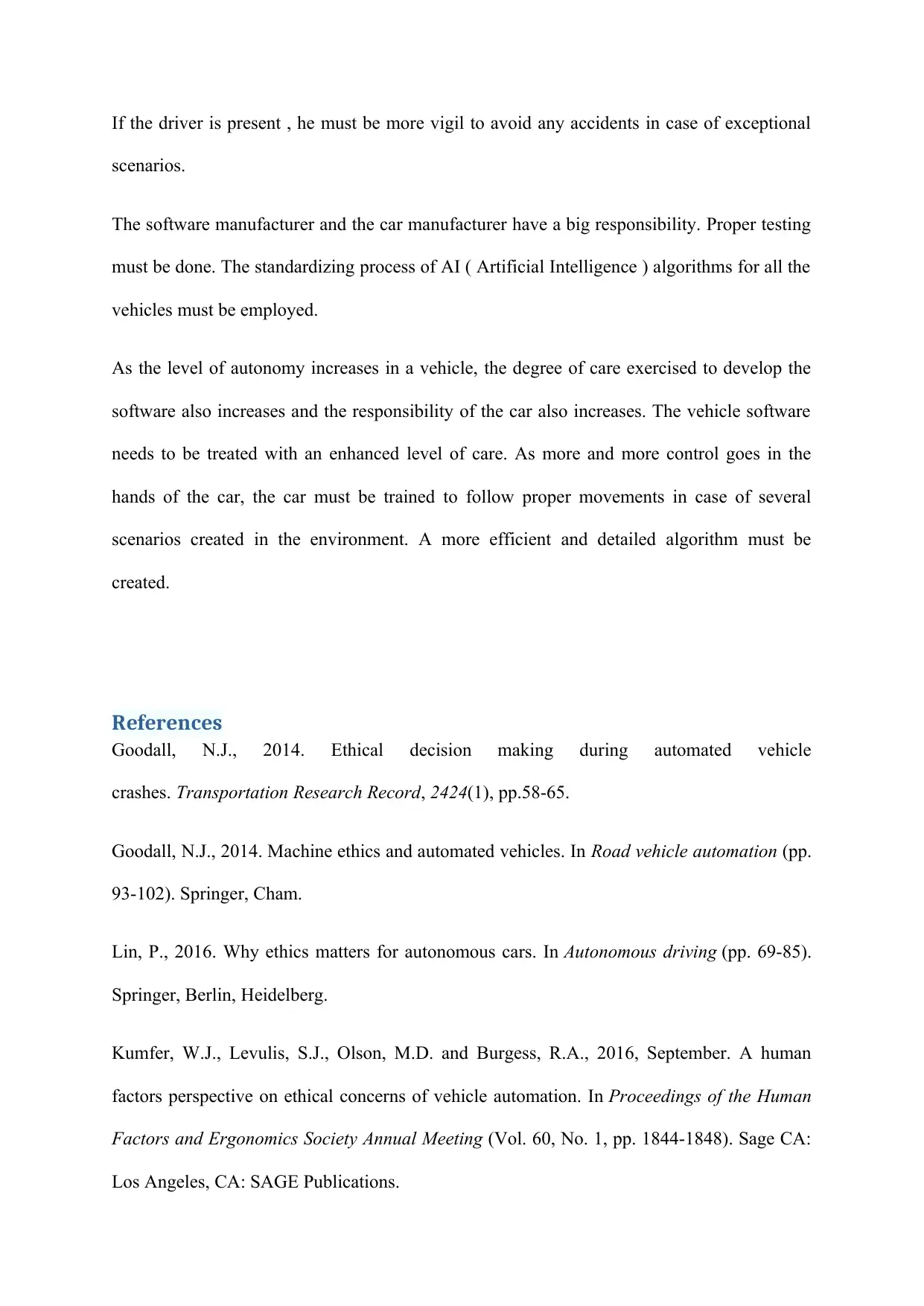
If the driver is present , he must be more vigil to avoid any accidents in case of exceptional
scenarios.
The software manufacturer and the car manufacturer have a big responsibility. Proper testing
must be done. The standardizing process of AI ( Artificial Intelligence ) algorithms for all the
vehicles must be employed.
As the level of autonomy increases in a vehicle, the degree of care exercised to develop the
software also increases and the responsibility of the car also increases. The vehicle software
needs to be treated with an enhanced level of care. As more and more control goes in the
hands of the car, the car must be trained to follow proper movements in case of several
scenarios created in the environment. A more efficient and detailed algorithm must be
created.
References
Goodall, N.J., 2014. Ethical decision making during automated vehicle
crashes. Transportation Research Record, 2424(1), pp.58-65.
Goodall, N.J., 2014. Machine ethics and automated vehicles. In Road vehicle automation (pp.
93-102). Springer, Cham.
Lin, P., 2016. Why ethics matters for autonomous cars. In Autonomous driving (pp. 69-85).
Springer, Berlin, Heidelberg.
Kumfer, W.J., Levulis, S.J., Olson, M.D. and Burgess, R.A., 2016, September. A human
factors perspective on ethical concerns of vehicle automation. In Proceedings of the Human
Factors and Ergonomics Society Annual Meeting (Vol. 60, No. 1, pp. 1844-1848). Sage CA:
Los Angeles, CA: SAGE Publications.
scenarios.
The software manufacturer and the car manufacturer have a big responsibility. Proper testing
must be done. The standardizing process of AI ( Artificial Intelligence ) algorithms for all the
vehicles must be employed.
As the level of autonomy increases in a vehicle, the degree of care exercised to develop the
software also increases and the responsibility of the car also increases. The vehicle software
needs to be treated with an enhanced level of care. As more and more control goes in the
hands of the car, the car must be trained to follow proper movements in case of several
scenarios created in the environment. A more efficient and detailed algorithm must be
created.
References
Goodall, N.J., 2014. Ethical decision making during automated vehicle
crashes. Transportation Research Record, 2424(1), pp.58-65.
Goodall, N.J., 2014. Machine ethics and automated vehicles. In Road vehicle automation (pp.
93-102). Springer, Cham.
Lin, P., 2016. Why ethics matters for autonomous cars. In Autonomous driving (pp. 69-85).
Springer, Berlin, Heidelberg.
Kumfer, W.J., Levulis, S.J., Olson, M.D. and Burgess, R.A., 2016, September. A human
factors perspective on ethical concerns of vehicle automation. In Proceedings of the Human
Factors and Ergonomics Society Annual Meeting (Vol. 60, No. 1, pp. 1844-1848). Sage CA:
Los Angeles, CA: SAGE Publications.
⊘ This is a preview!⊘
Do you want full access?
Subscribe today to unlock all pages.

Trusted by 1+ million students worldwide
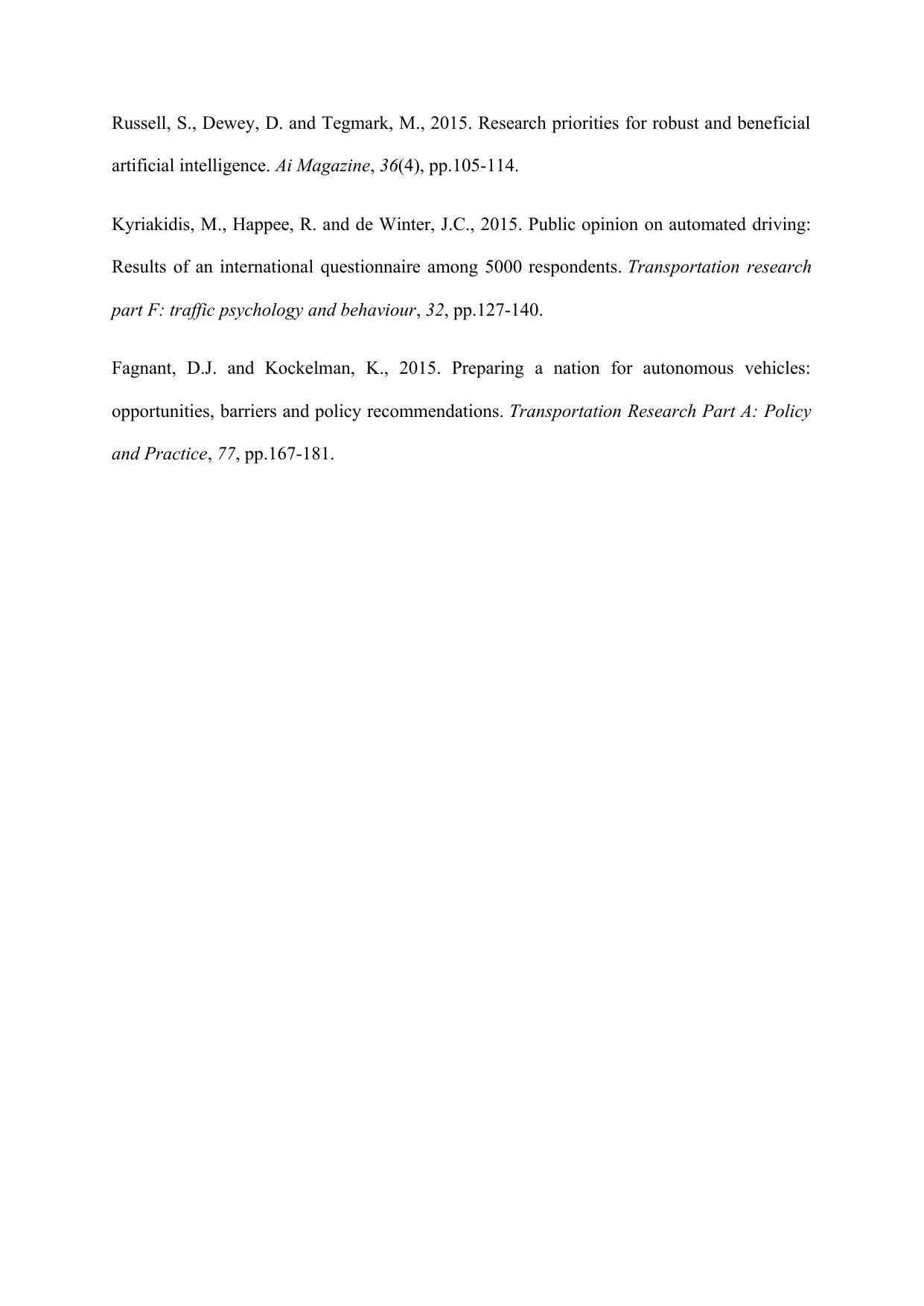
Russell, S., Dewey, D. and Tegmark, M., 2015. Research priorities for robust and beneficial
artificial intelligence. Ai Magazine, 36(4), pp.105-114.
Kyriakidis, M., Happee, R. and de Winter, J.C., 2015. Public opinion on automated driving:
Results of an international questionnaire among 5000 respondents. Transportation research
part F: traffic psychology and behaviour, 32, pp.127-140.
Fagnant, D.J. and Kockelman, K., 2015. Preparing a nation for autonomous vehicles:
opportunities, barriers and policy recommendations. Transportation Research Part A: Policy
and Practice, 77, pp.167-181.
artificial intelligence. Ai Magazine, 36(4), pp.105-114.
Kyriakidis, M., Happee, R. and de Winter, J.C., 2015. Public opinion on automated driving:
Results of an international questionnaire among 5000 respondents. Transportation research
part F: traffic psychology and behaviour, 32, pp.127-140.
Fagnant, D.J. and Kockelman, K., 2015. Preparing a nation for autonomous vehicles:
opportunities, barriers and policy recommendations. Transportation Research Part A: Policy
and Practice, 77, pp.167-181.
1 out of 10
Related Documents
Your All-in-One AI-Powered Toolkit for Academic Success.
+13062052269
info@desklib.com
Available 24*7 on WhatsApp / Email
![[object Object]](/_next/static/media/star-bottom.7253800d.svg)
Unlock your academic potential
Copyright © 2020–2025 A2Z Services. All Rights Reserved. Developed and managed by ZUCOL.





